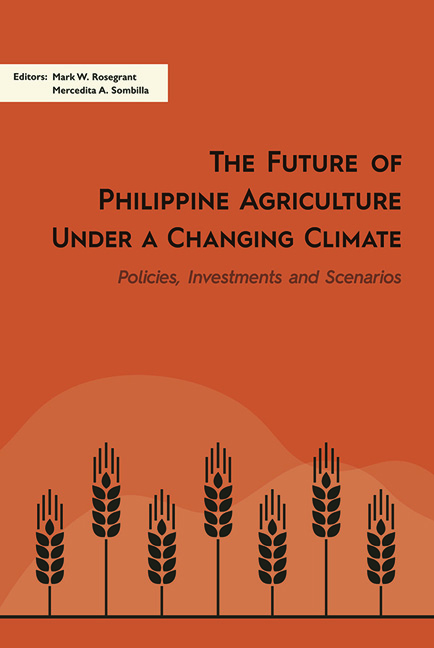Book contents
- Frontmatter
- Contents
- List of Tables
- List of Figures
- List of Appendices
- Preface
- Acknowledgements
- List of Contributors
- PART I Setting up the Scenarios: Current Status and Potential Impacts of Climate Change to Philippine Agriculture
- PART II Climate Change Adaptation Strategies and Sustainability of Philippine Agriculture
- PART III Investments and Supporting Policies to Alleviate Climate Change Impacts to Philippine Agriculture
- 9 A Biophysical Approach to Modelling Alternative Agricultural Futures under Climate Change
- 10 A Partial Equilibrium Approach to Modelling Alternative Agricultural Futures under Climate Change
- 11 A General Equilibrium Approach to Modelling Alternative Agricultural Futures under Climate Change
- PART IV Conclusion
- Index
10 - A Partial Equilibrium Approach to Modelling Alternative Agricultural Futures under Climate Change
from PART III - Investments and Supporting Policies to Alleviate Climate Change Impacts to Philippine Agriculture
Published online by Cambridge University Press: 29 May 2019
- Frontmatter
- Contents
- List of Tables
- List of Figures
- List of Appendices
- Preface
- Acknowledgements
- List of Contributors
- PART I Setting up the Scenarios: Current Status and Potential Impacts of Climate Change to Philippine Agriculture
- PART II Climate Change Adaptation Strategies and Sustainability of Philippine Agriculture
- PART III Investments and Supporting Policies to Alleviate Climate Change Impacts to Philippine Agriculture
- 9 A Biophysical Approach to Modelling Alternative Agricultural Futures under Climate Change
- 10 A Partial Equilibrium Approach to Modelling Alternative Agricultural Futures under Climate Change
- 11 A General Equilibrium Approach to Modelling Alternative Agricultural Futures under Climate Change
- PART IV Conclusion
- Index
Summary
The future of Philippine agriculture ultimately depends on the extent of climate change's impact and the choices governments, agricultural producers, and consumers make in efforts to adapt to these impacts. This chapter focuses on modelling the economic impacts of climate change on Philippine agriculture, emphasizing the potential for adaptation technologies and government investment policies not only to assist the country in proactively preparing for and mitigating these impacts, but also to achieve its food security objectives. The main instrument underlying the modelling and analyses in this chapter is the International Model for Policy Analysis of Agricultural Commodities and Trade (IMPACT), a partial equilibrium economic model developed and maintained by the International Food Policy Research Institute. The model facilitates the simulation of the impacts and costs of climate change; the effectiveness of existing and emerging production technologies and strategies; and the contribution of demographic, development, and investment policies to food security and climate change adaptation efforts (for details of the model, see Rosegrant and the IMPACT Development Team 2012).
The analyses presented in this chapter are based on model simulations undertaken using an interlinked combination of modelling tools: the Decision Support System for Agrotechnology Transfer (DSSAT), a biophysical crop-model described in Chapter 9 (this volume), the IMPACT model (briefly described above and in more detail in Rosegrant and the IMPACT Development Team (2012)), including the IMPACT-WATER model (described in Rosegrant, Cai, and Cline (2002) and updated and expanded since then), and a dynamic computable general equilibrium (DCGE) model for the Philippines described in Chapter 11 (this volume). The technical linkages among these models were earlier described in Chapter 9.
Simulations were undertaken under four future climate scenarios derived from the following general circulation/climate models: the General Fluid Dynamics Laboratory (GDFL), Hadley Centre Global Environmental Model (HadGEM), Institut Pierre-Simon Laplace (IPSL), and the Model for Interdisciplinary Research on Climate (MIROC). Two primary scenarios were modelled for the 2011–50 period, one being the baseline scenario without climate change, and one a scenario with climate change based on the average results from the GDFL, HadGEM, IPSL, and MIROC simulations. In detailed technology assessments the MIROC model was used because it was deemed to be the most accurate simulation of the future Philippine climate.
- Type
- Chapter
- Information
- The Future of Philippine Agriculture under a Changing ClimatePolicies, Investments and Scenarios, pp. 450 - 491Publisher: ISEAS–Yusof Ishak InstitutePrint publication year: 2018



